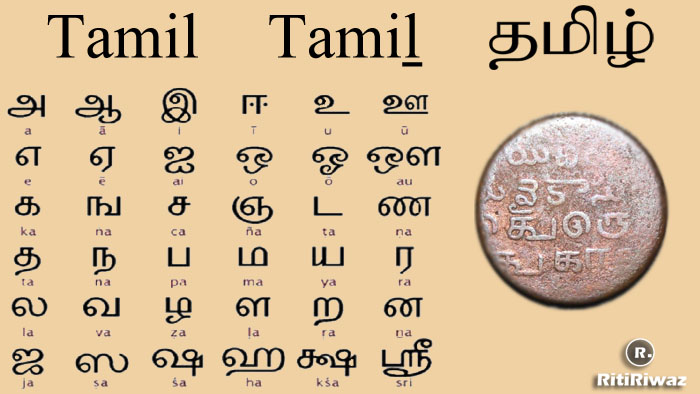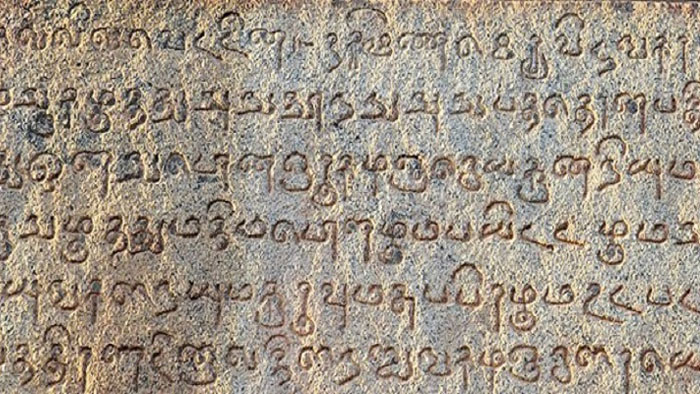Tamil Language | Tamil History and Facts

Tamil (தமிழ் ) is part of the Dravidian language family spoken by Tamil people in India, Sri Lanka, and Singapore. It is one of the most ancient languages in the world and you can find speakers of Tamil in Malaysia, Mauritius, Fiji, and South Africa. In India, Tamil is the official language of Tamil Nadu and the union territory of Puducherry and is spoken by significant speakers in Telangana, Kerala, Andhra Pradesh, Karnataka, and Andaman and the Nicobar Islands.
Telugu, Kannada, and Malayalam languages have borrowed from Sanskrit, sounds, and words. But Tamil has tried and has succeeded in its attempt to remain almost unaffected by the influence of that great language, Sanskrit. As such Tamil is considered to be the most difficult of the Dravidian Languages to learn. It cannot be denied that Tamil also has borrowed words from Sanskrit. But the percentage of words borrowed, compared to the other languages of the same family, is very much less.
Tamil is the only language that is also personified as a god. Tamil Thai temple in Karaikudi, Tamil Nadu is considered the deified personification of the Tamil language as a mother.
History

Tamil is one of the richest and oldest languages in the world. No one can understand Indian culture fully without studying Tamil and Tamil culture. It is on par with Sanskrit, Greek, Hebrew, Chinese, and Latin in its richness.
The history of the Tamil language is divided into three periods, namely –
(1) Early Tamil, comprising the period between the sixth century before and the sixth century after Christ. The earliest inscription of Tamil writing can be found from the 15th century BCE.
(2) Medieval Tamil, between the sixth century and the twelfth century. The Medieval Tamil period The struggle for predominance between Hinduism on the one hand and Buddhism and Jainism The literature of this epoch consists of hymns to Siva and Vishnu The Tamil grammar during this period was VIRASOLIYAM, Nambi’s AHAPPORUL, and NEMINADAM.
(3) Modern Tamil, from the twelfth century down to the present day.
The earliest inscription of Tamil writing can be found from the 15th century BCE. Among Indian languages, Tamil has the most ancient Non- Sanskritic Indian literature. Off late it has borrowed words from Sanskrit. Scholars categorize the attested history of the language into three periods: Old Tamil (300 BC-AD 700), Middle Tamil (700–1600), and Modern Tamil (1600–present).
In November 2007, an excavation at Quseir -al- Qadim revealed Egyptian pottery dating back to the first century BC with ancient Tamil Brahmi inscriptions. John Guy states that Tamil was the lingua franca for early maritime traders from India. According to Hindu legend, Tamil, or in personification from Tamil Thāi (Mother Tamil) was created by Lord Shiva. Murugan, revered as the Tamil God, along with sage Agastya, brought it to the people. The earliest extant Tamil literary works and their commentaries celebrate the Pandiyan Kings for the organization of long-termed Tamil Sangams, which researched, developed, and made amendments to the Tamil language.
Tamil was the first language that went into print in India. The oldest book was printed in Tamil. Harvard University (USA) museum has the oldest book “Thambiran Vanakkam” on display. The oldest Tamil book available today is Tolkappiyam written by Tolkappiyar. The book is a grammatical treatise dated first century BC or AD.
Tamil Writing

Tamil is classified as a Dravidian language and it is spoken by over 100 million people. Most of the Tamil speakers are in India. Other traditional areas are Sri Lanka, Malaysia, Singapore, South Africa, Fiji, Mauritius, Reunion, France, and Guyana. Now Tamils are found everywhere from the South Pole to the North Pole in almost all countries in the world but in small numbers. Telugu, Tulu, Malayalam, and Kannada are the sister languages of Tamil.
Tamils call their vowels ‘life letters’ and the consonants ‘body letters’. Needless to say, it needs to function together. So the vowel consonants are called ‘life body’ letters. This is a unique approach to alphabets. Tamils have a unique letter. We can’t even write it in any other language. So it is transliterated as ‘za’ in English. One has to curve one’s tongue and the tip of the tongue should touch the back of the upper part of the mouth. It is a retroflex letter. Scholars point out that the French rolling “ r ’’ sound and a letter in the Chinese language come closer to the Tamil “ za “. E.g.Pazam in Tamil means fruit in English.
Some people find it difficult to learn this language because of three ‘ l ’ sounding letters and three ‘n’ sounding letters and two ‘r’ sounds. But practice makes one perfect. Christian missionaries mastered Tamil and Sanskrit to spread their religion.
Tamil alphabet has 247 letters (12 vowels,18 consonants,216 vowel consonants, and one more mysterious letter called Aytha Ezuthu. It is written with three dots and pronounced as ‘AH’. It has become almost obsolete today. The origin and use of this letter are a mystery. Scholars are still debating. Some people consider it may be like Sanskrit Visarga ‘:’ sound that brings out various missing sounds in Tamil.
Notable features
• Type of writing system: syllabic alphabet
• Direction of writing: left to right in horizontal lines
• When they appear at the beginning of a syllable, vowels are written as independent letters.
• Some of the non-standard consonant-vowel combinations are not used in official documents.
• The alphabet was originally written on palm leaves. As a result, the letters are made up mainly of curved strokes which didn’t rip the leaves.
Tamil Dialects
As with many other long-established literary languages, there is marked diglossia among native Tamil speakers. A ‘high’ or literary variety (referred to in this dissertation as Literary Tamil or LT) is spoken by educated speakers informal contexts and is the norm in the media, public speaking, and the stage. There is relatively little dialectical variation in spoken LT. In a colloquial speech, by contrast, there is very marked dialectical variation across a number of dimensions: geographical, social class, caste, and ethnicity.
It is claimed that a standard spoken dialect of South India has emerged, being the informal speech of educated speakers used in the major urban areas and increasingly used in the cinema and in television drama and chat shows (Asher 1985). It is this ‘standard’ dialect that is described in the recent grammar listed above and is used as one of the dialects for this dissertation. The dialect is referred to simply as Spoken Tamil or ST.
Though it is not used in everyday informal contexts, exposure to LT is so pervasive that competence in it (as listeners at any rate) is more or less universal. Tamil, therefore, shows classic diglossia (Ferguson, 1959). Colloquial dialects of Tamil are regarded popularly and by historical linguists (see for example Andronov, 2003, Krishnamurti, 2003) as having evolved or derived from classical Tamil. However, as seems to be the case with diglossia in Arabic (Owens, 2001), it is quite likely that the colloquial dialects of Tamil co-existed from pre-literate times with the dialect which came to be the ‘high’ or the literary dialect.
Literature
Tamil literature has a literary tradition spanning more than two thousand years. The revival of Tamil literature took place in the late nineteenth century, The nationalist poets start using the power of poetry in influencing the masses. With the growth in literacy, Tamil began to blossom and short stories and novels began to appear. Tamil literature goes back to the Sangam Era after the Sangam period two epic was written namely Silappadikaram and Manimeghalai.
Agastya was the first man to write a grammar for Tamil. But we lost it. His disciple Tolkappiyar wrote another book that is available today. Sage Agastya’s name is mentioned even in Rig Veda, the oldest religious book that is available today. But it is a clan (gotra) suffix. Anyone born in that clan is called Agastya. So, Agastya linked to Tamil was a later one. Scholars believe he lived around 1000 BCE. These narratives continue to be read and studied and constitute an important component of the Tamil cult.
Suggested Read: Tamil Nadu – Culture and Tradition






